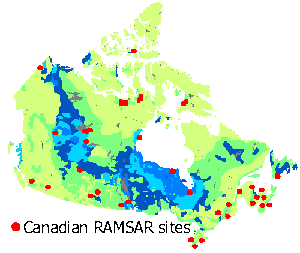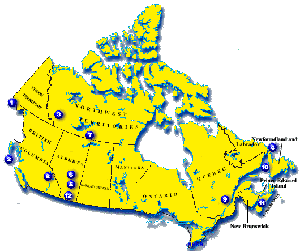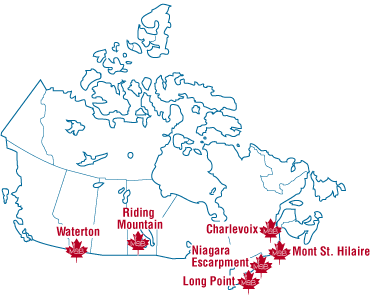Successful biodiversity
conservation efforts require international agreements because
wildlife and pollution do not respect political boundaries. Canada's
populations of wildlife are also residents of the United States
and Mexico, Central and South America and other circumpolar countries.
Therefore the fifth goal of the Canadian Biodiversity Strategy
seeks to establish cooperative efforts at the international level
to protect species and habitat biodiversity.
Canada has been very
active internationally in support of the CBD.
- It has co-sponsored
workshops and symposia in Costa Rica, Chile, and Cote d'Ivoire.
- It has participated
in and hosted meetings of the UNEP Expert Panels, and has played
an active role in the two meetings of the Inter-governmental Committee
for the CBD.
- At the first two meetings
of the Conference of the Parties (COP) in the Bahamas and Indonesia
respectively, Canada co-hosted a Biodiversity Technology Fair.
- Through the Commission
for Environmental Cooperation, Canada has entered into cooperative
biodiversity programs with its NAFTA partners.
- The Canadian Museum
of Nature is assisting other countries in the production of biodiversity
country studies.
- Finally, Canada is
collaborating in an OECD project to develop biodiversity indicators,
and with Germany, Australia, and the World Conservation Monitoring
Centre on the creation of an international Clearing House Mechanism
for scientific and technical information exchange.
Some of the international
protection agreements of which Canada is an active participant
are discussed below.
RAMSAR
Sites
The Convention on Wetlands
of International Importance, also known as the RAMSAR Convention,
was named after the city in Iran where the text was first adopted
in 1971 with the cooperation of 18 nations. The Convention is
a treaty that provides the framework for international cooperation
for the conservation of the World's wetland habitats. As of mid-1995,
84 nation states comprised the Contracting Parties to the Convention
worldwide. (The Wetlands Network)
Where are Canada's RAMSAR
sites?
 |
As
of 1996, there were 33 designated RAMSAR sites across Canada. |
CITES
Known as CITES, the
Convention on International Trade in Endangered Species of Wild
Fauna and Flora entered into force on July 1, 1975 and now has
a membership of 143 countries. These countries act by banning
commercial international trade in an agreed list of endangered
species and by regulating and monitoring trade in others that
might become endangered. (CITES
website)
Many species are declining
in number because of loss of habitat and increased exploitation
as human populations grow. Trade has now also become a major factor
in the decline as improvement in transport facilities has made
it possible to ship live animals and plants and their products
anywhere in the world.
The wildlife trade is a highly
lucrative business and involves a wide variety of species, both as live
specimens and as products. Millions of animals and plants are traded
each year to supply the demand for pets and ornamental plants. Furs,
leather and timber, and articles manufactured from these materials are
all traded in large quantities. (CITES
website)
UNESCO
World Heritage Sites
Recognizing that the
world's cultural and natural heritage transcends national boundaries
and must be preserved for future generations, the Member States
of UNESCO in 1972, unanimously adopted a Convention concerning
the Protection of the World Cultural and Natural Heritage, known
in short as the World Heritage Convention. As of July 1997, 150
states had adhered to the convention. Canada adhered in 1976.
The Convention provides
for:
-
Establishment of a World Heritage Committee.
- Compilation of
a World Heritage List to include cultural and natural properties
throughout the world that are considered to be of outstanding
universal value according to criteria drawn up by the World
Heritage Committee. As of July 1997, the committee, comprised
of experts in cultural and natural conservation from
21 states, had named 506 sites to the List.
- Preparation of
a List of World Heritage in Danger.
- Establishment
of a World Heritage Fund to provide aid to Member States for
World Heritage Sites. Each state adhering to the Convention
pays one per cent of its contribution to the Regular Budget
of UNESCO to the World Heritage Fund.
- Provision of technical
and emergency assistance, upon request, to Member States.
- General promotion
throughout the world of the importance of heritage conservation.
(Parks Canada
Website)
Which
are the Canadian World Heritage sites?
|

|
As of 1996, Canada
had 12 designated World Heritage Sites.
In Quebec, the old
district of Quebec City has been designated a UNESCO World Heritage
District
|
(Parks
Canada Website)
UNESCO
Man and Biosphere Reserves
UNESCO launched the
Man and the Biosphere (MAB) program in 1971 with the goal of improving
human involvement with nature, in ways which satisfy human needs
and support the long term health of the natural system.
The program was divided
into 14 sub-themes such as mountain ecosystems, tropical ecosystems,
etc. The largest of the sub-programs focus on the conservation
of genetic material in key ecosystems around the world; areas
which UNESCO designates as biosphere reserves.
(Canada
MAB Website)
Which
are Canada's MAB reserves?
 |
Canada
currently has six designated MAB reserves as well as 1 more being
proposed. |
(Canada
MAB Website)